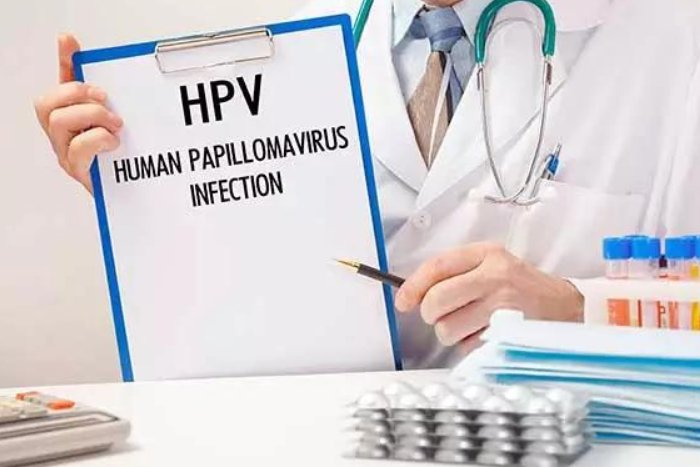ALL YOU NEED TO KNOW ABOUT HUMAN PAPILLOMAVIRUS: SYMPTOMS AND PREVENTION

WHAT IS HUMAN PAPILLOMAVIRUS INFECTION?
Human Papillomavirus (HPV) is a common, sexually transmitted infection (STI) that is easily transmitted during sexual contact. Most Human Papillomavirus or HPV infections will disappear with no treatment, but few variants of the virus can cause genital or anal warts or even lead to cancer. HPV cannot be treated by medication, but a vaccine is available to prevent some types of HPV. Consistent use of condoms can reduce but not eliminate the risk of getting or passing on HPV during sex.
There are many different strains of the virus, each identified with a number. HPV-16 and HPV-18 are high-risk types known to increase the risk of cervical, vaginal, and vulvar cancer in women and penile cancer in men. The strains can also cause anal cancer and throat cancers in men and women.
WHAT CAN CAUSE HPV?
The virus that causes HPV infection is transmitted through skin-to-skin contact. Most people get a genital area HPV infection through direct sexual contact, including vaginal, anal, and oral sex.
Because HPV is a skin-to-skin infection, intercourse is not required for transmission to occur. Many people have HPV and do not even know it, which means you can still contract it even if your partner does not have any symptoms. It is also possible to have multiple types of HPV.
In rare cases, a mother who has HPV can transmit the virus to her baby during delivery. When this happens, the child may develop a condition called recurrent respiratory papillomatosis, where they develop HPV-related warts inside their throat or airways.
HOW CAN ONE GET HPV?
Anyone who has had sexual skin-to-skin contact is at risk for HPV infection. Other factors that may put someone at an increased risk for HPV infection include:
· Amplified number of sexually active partners
· Unprotected vaginal, anal, or oral sex health
· A weak immune system
· Having an HPV sexual partner
If you contract a high-risk type of HPV, some factors can make it more likely that the infection will continue and may develop into cancer:
· Having other STIs, like, Chlamydia, Gonorrhea, and Herpes simplex
· Chronic inflammation
· Having many children may lead to cervical cancer.
· Using oral contraceptives over a long period may lead to cervical cancer.
· Using tobacco products may lead to mouth or throat cancer.
· Unprotected anus/penis sex can lead to anal cancer. Over 90% of anal cancer cases are due to previous human papillomavirus (HPV) infection. HIV-positive men who have sex with men have been reported to have anal cancer rates that are three times those of the highest cervical cancer rate seen in the general population.
WHAT ARE THE SYMPTOMS OF HPV?
There is a high possibility that people with HPV do not experience noticeable symptoms or health problems. They are mostly unaware that they have the infection and probably transmit it to other people. In 80 per cent of cases, the virus will be naturally cleared by the body’s immune system within about two years.
However, when the HPV infection lingers, symptoms and health risks can develop. In most cases, your body’s immune system defeats an HPV infection before it creates warts. When warts do appear, they may differ in appearance depending on which kind of HPV is involved following are some symptoms:
1. Genital warts: These appear as flat lesions, small cauliflower-like bumps, or tiny stem-like protrusions. In women, genital warts appear mostly on the vulva and occur near the anus, on the cervix, or in the vagina. In men, genital warts appear on the penis and scrotum or around the anus. Genital warts rarely cause discomfort or pain, though they may itch or feel tender.
2. Common warts: Common warts appear as rough, raised bumps and usually occur on the hands and fingers. In most cases, common warts are unsightly, but they can also be painful or susceptible to injury or bleeding.
3. Plantar warts: Plantar warts are hard, grainy growths that usually appear on the heels or balls of your feet. These warts might cause discomfort.
4. Flat warts: Flat warts are flat-topped, slightly raised lesions. They can appear anywhere, but children usually get them on the face, and men tend to get them in the beard area. Women tend to get them on the legs.
5. Cervical cancer: HPV infections cause nearly all cervical cancers, but cervical cancer may take 20 years or longer to develop after an HPV infection. The HPV infection and early cervical cancer typically don’t cause noticeable symptoms. Getting vaccinated against HPV infection is your best protection from cervical cancer.
The most critical risk factor for cervical factor is human papillomavirus (HPV) infection; virtually all cervical cancer screenings are associated with HPV infection. Over a hundred types of HPV and more than a dozen strains are referred to as “high-risk” types that can cause abnormal cells to form on the cervix over time.
About two-thirds of all cervical cancers are caused by HPV-16 and HPV-18 strains. Abnormal cervical cells caused by HPV infection can further mutate, increase and develop into cervical cancer if not excised. Although a Pap test doesn’t diagnose HPV, it is a screening test for abnormal cells caused by HPV infection.
HOW CAN ONE PREVENT HPV?
The easiest ways to disease control and prevent HPV are to use condoms and to practice safe sex.
In the last decade, molecular diagnostics has seen tremendous advancements that help medical professionals, doctors and lab specialists in detecting early signs of diseases such as cancer. The Western blot analysis is one such technique that has been crucial in the detection of cervical cancer.
With the help of the Western blotting technique, lab specialists can evaluate the clinical value of HPV E6 and E7 oncoprotein detection for the early screening of cervical cancer.
In the domain of molecular diagnostics, the direct identification of proteins through western blotting procedure is efficient and has proven significantly advantageous for confirmatory testing for disease diagnosis.
But for a successful western blot analysis it is important to select the correct antibody and identify the optimal concentration and optimised results need the right equipment.
HHC provides in the ZeptoMetrix WESTERN BLOT for in vitro detection of antibodies to SIV (Simian Immunodeficiency Virus, the lentivirus most closely related to Human HIV) in serum or plasma. It is available in 10 or 30 strip kit formats.
If you want to add the most updated lab equipment to enhance the protein detection services of your lab, don’t hesitate to get in touch with Helvetica Health Care Website now!
